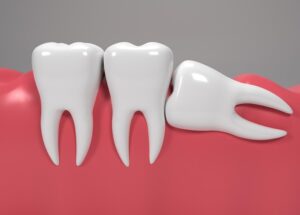
Wisdom teeth, also known as third molars, are the last set of teeth to emerge, typically appearing between the ages of 17 and 25. While some people experience no issues with their wisdom teeth, others may face problems like overcrowding, pain, or infection. In such cases, wisdom tooth extraction becomes necessary to maintain oral health and prevent further complications.
Why Is wisdom tooth extraction Necessary?
Wisdom teeth often cause problems because they don’t always have enough space to grow properly. This can lead to various dental issues, including:
- Impaction
Wisdom teeth may become trapped under the gum line or partially emerge, causing pain and swelling. - Overcrowding
Their growth can push other teeth out of alignment, affecting your bite and smile. - Infections
Partially erupted wisdom teeth create pockets where food particles and bacteria can get trapped, leading to gum infections or tooth decay. - Cysts or Tumors
In rare cases, impacted wisdom teeth can form cysts, which may damage surrounding teeth and bone.
The wisdom tooth extraction Process
If your dentist or oral surgeon recommends wisdom tooth extraction, here’s what you can expect:
- Initial Consultation
Your dentist will take X-rays to evaluate the position of your wisdom teeth and determine the complexity of the procedure. - Preparation
On the day of the procedure, local anesthesia, sedation, or general anesthesia will be administered to ensure your comfort. - Extraction
- Simple Extraction: If the tooth is fully erupted, it is removed using standard dental tools.
- Surgical Extraction: For impacted or partially erupted teeth, an incision is made in the gum to access and remove the tooth.
- Stitches and Recovery
The area may be stitched up to promote healing, and gauze is placed to control bleeding.
Recovery After wisdom tooth extraction
Recovery time varies depending on the complexity of the extraction. Here are some tips to ensure a smooth healing process:
- Manage Pain and Swelling
- Use prescribed pain relievers or over-the-counter medication as directed.
- Apply an ice pack to reduce swelling during the first 24 hours.
- Diet and Hydration
- Stick to soft foods like yogurt, soup, and mashed potatoes.
- Avoid hot, spicy, or crunchy foods that could irritate the extraction site.
- Oral Hygiene
- Avoid brushing near the extraction site for the first 24 hours.
- Rinse gently with salt water after meals to keep the area clean.
- Avoid Certain Activities
- Refrain from smoking, using straws, or vigorous rinsing to prevent dry socket, a painful condition where the blood clot dislodges.
When to Call Your Dentist
While complications are rare, it’s essential to contact your dentist if you experience:
- Excessive bleeding beyond 24 hours.
- Severe pain that doesn’t improve with medication.
- Signs of infection, such as fever, swelling, or pus.
- Numbness or tingling in your lips or tongue.
Benefits of wisdom tooth extraction
- Prevention of Future Issues
Removing problematic wisdom teeth reduces the risk of overcrowding, infections, and other complications. - Relief from Pain
Extraction alleviates discomfort caused by impacted or misaligned teeth. - Improved Oral Health
By eliminating a potential source of decay and infection, you maintain better long-term dental health.
Conclusion
wisdom tooth extraction is a common and often necessary procedure to address issues caused by problematic third molars. While the thought of extraction might seem daunting, modern techniques and sedation options ensure a comfortable experience. If you’re experiencing discomfort or your dentist has recommended removing your wisdom teeth, consult with a qualified oral surgeon to take the first step toward a healthier, pain-free smile.







